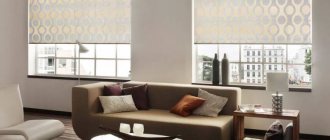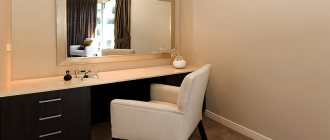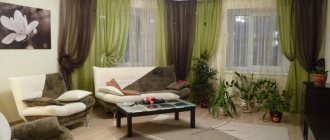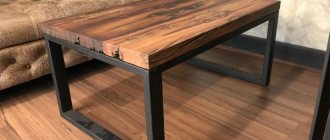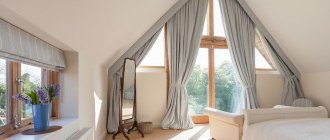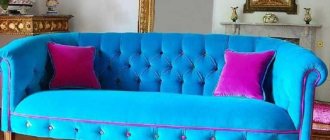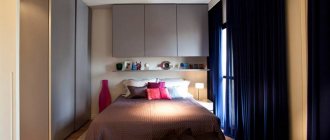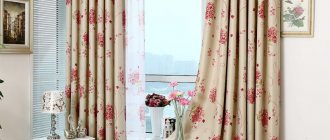Advantages
These curtains, as the name suggests, appeared in Ancient Rome. Since then, they have remained virtually unchanged, which speaks to the quality of the design and other advantages.
beauty
Initially, curtains appeared in the houses of wealthy nobles to protect their homes from the dust that rose from horse-drawn carriages. Over time, wives began to decorate the canvas with embroidery and even mosaics.
The beauty of Roman blinds is their simplicity, neatness, elegance and variety of different designs. You can choose either a regular plain version or one decorated with a pattern with golden threads - such a canvas will look great even in a classic-style kitchen.
Fabric folds make the interior cozier, which is exactly what is needed when the whole family gathers at the dining table.
Practicality
Curtains are practical due to their short length - they do not roll on the floor and do not collect dust. The advantage is that the length of Roman blinds is adjustable, allowing you to even change the level of lighting.
If during the day you want to fully enjoy the sunshine, then in the evening you want to hide from the prying eyes of passers-by. Especially if the apartment is on the first floor. Or, conversely, at noon you can close the curtains at least halfway so that the kitchen does not heat up if it is on the sunny side.
In essence, Roman blinds are similar to horizontal blinds, but they look much cozier. They are also often compared to roller blinds, but adjusting the latter is more difficult than their Roman counterpart.
Possibility of combination
Since Roman blinds are quite simple in appearance, they can easily be combined with additional decor. Lambrequins or curtains are usually used. This allows you to create a unique window decoration and match the kitchen interior as much as possible. This method is often used in combined kitchens and living rooms.
The picture shows a 2020 interior design with a combination of Roman curtains and curtains at the balcony door.
Suitable for small kitchens
Often the design of apartment buildings is such that the kitchen area does not have the desired dimensions. Roman blinds, due to their shape and length, do not overload the interior and can be used even in the smallest and most austere kitchen.
Variety of styles
It is the variety of different designs that allows you to fit this decorative detail into any interior: from loft to empire style. If just curtains are not enough, you can always add lambrequins or other decoration to them.
The composition of the fabric also plays an important role: if the Scandinavian style requires only pure cotton or linen, then the Empire style will want fabric made of natural silk, decorated with beautiful patterns.
Hand-Made
The simple style of the curtains allows you to sew them yourself in just a few hours. Surely this will work out faster than deciding on the color and pattern of the canvas. An additional advantage will be low fabric consumption. The main thing is to have a sewing machine.
Easy care
It is not difficult to care for such curtains, since most often they are simply removed; the fabric is easily washed and smoothed under the weight of the weight plate in the bottom layer of the fabric. But it’s worth looking at each specimen separately, since sometimes the panels cannot be removed from the curtains, which makes maintenance more difficult.
Advantages of Roman blinds for the kitchen
Roman blinds are a fabric fabric that gathers into folds when raised. You can raise them using slats that are sewn on the reverse side. In their design and convenience, they resemble blinds, while their beautiful outline is in no way inferior to curtains.
So, the advantages of Roman blinds include the following:
- Beautiful appearance. Such curtains will transform any interior, add coziness, and complement the style of the room with an exquisite design or pattern. The main thing is to choose the right material;
- Practicality. They are compact, do not take up much space, as they are adjacent to the window. In addition, thanks to the weights, they do not fly apart;
- Ease of lighting control. This is possible due to the ease of changing the length of the blade using a special chain;
- Pairs perfectly with curtains. This is relevant for zoning space, especially in studio apartments;
- Do not overload the interior. This is especially important for small kitchens. Since Roman blinds are laconic, do not have a lush arrangement, and repeat the size of the window, in a small room they look more comfortable than large draperies and heavy curtains;
- Versatility. You can choose the appropriate option for any style, using a certain texture and color;
- Easy to care for. It is enough to sometimes vacuum them or wipe them with a damp cloth. If the stains are strong, they can be removed and washed;
- Possibility to sew it yourself. Having fabric, fasteners and weights will allow you to sew Roman blinds with your own hands in a couple of hours. There is nothing complicated about this.
Such curtains are positive from all sides. The only minor drawbacks are that they cannot be moved to the side, and to open the window you will need to lift them completely. However, such disadvantages are insignificant compared to all the positive aspects.
Flaws
Such beautiful window decor has its drawbacks. Most often, people consider them insignificant, so they do not refuse to install Roman blinds. But you need to know the enemy by sight, so let’s take a look at the disadvantages of this decor.
Ventilation
Interaction with the window will be complicated. For example, you cannot open a window wide open, since the cornice can limit the movement of the sash. You won’t be able to quickly look out of the window either—you’ll have to lift the canvas first.
These situations are only possible if the curtain is common and acts on both sashes, and the cornice hangs above the window. If the curtain is designed for each sash separately, and the cornice is fixed to the frame, then the problems listed above will not arise.
Wash
If the curtain has a complex design, then caring for it will be difficult. Each time you will have to completely disassemble and reassemble the curtain and its fastenings, remove its guides and remove the cords.
Otherwise, Roman blinds are universal. More precise characteristics depend on the selected fabric. If you prefer mixed fabrics , such a curtain will serve for a long time without fading in the sun and without absorbing kitchen odors.
Types of structures
Based on their appearance and design, there are three types of curtains:
- classic - when unraveled, they are a smooth fabric without gathers. Smooth and neat layers are formed only when the canvas is folded and the window is opened. Due to the simple design and device, they are ideal for children's rooms and kitchens;
- cascading - differ in that even in the loose version they have folds and draperies. A very beautiful and sophisticated option that is more suitable for a bedroom, living room or kitchen in a classic or empire style;
The photo shows the design solution for 2020.
- frameless - the simplest type of Roman blinds. Their peculiarity is the absence of hinges and weights. Often this particular model is sewn by housewives themselves. With a beautiful pattern, the canvas is suitable for a country or Provence style kitchen.
It is the latter type of curtains that most often has different ways of attaching to the window. On top, the canvas may have fastening loops for attaching to the cornice. Or the fabric can be held in place by regular Velcro tape placed above the window.
How to attach
For any curtains, the main tasks are the same:
- protection from the sun and the curiosity of passers-by;
- interior decoration.
Regardless of where the canvas is attached, it will perform these functions. There are several options for what to attach to:
|
|
|
|
If the window sill will be used as a work area, it is better to choose the first or second mounting option so that the fabric does not interfere with cooking. It is worth paying attention to this type of fastener and, if you wish, storing something on the windowsill and growing greens on it.
If it is important to hide the slopes, then the cornice is mounted on the wall. This option is suitable for large windows when the use of additional decor is not planned. Ceiling fasteners are not used in the kitchen due to their impracticality.
Roller blinds
Also known as fabric roller blinds. It is generally accepted that the first roller blinds appeared in the Arab Caliphate (medieval Muslim empire), when “women’s seclusion” dominated in families and jealous men did not want their wives to become the object of prying eyes from the street. These first products were made of wood and coarse flax with plant paintings. They did not have an adjustment mechanism, and the main function was to make it impossible to inspect the house from the outside.
Roller curtains acquired a more or less modern look in the 18th century in production in Britain, where fabric for curtains was bleached, dyed, starched and rolled out with wooden rollers to give shape. The processing process then took an average of 10 days.
Today, conveyor production allows us to produce dozens of curtains per day. Modern roller blinds come in two types: “closed” and “open”.
"Closed" type roller blinds
The closed roller blind system is suitable for windows where the glazing bead depth exceeds 15 mm. In a closed system, the upper shaft with the curtain is closed by a special aluminum box. U-shaped strips are attached along the sides of the window, which ensure a strict vector of movement of the roll without bevels or deviations. Due to the possibility of installing a “closed” system on a window opening, this type of roller blinds successfully harmonizes with the interior of both large and small rooms.
An example of a “closed” roller blind design
The “closed” roller blind system includes the “Uni” and “Profile” subsystems. The fundamental difference between them, as a rule, is only that the “Profile” is mounted at a distance from the glass, thereby taking up a little more space, visually making the window more convex.
"Open" type roller blinds
A more simplified and cheaper model of roller blinds. The shaft with the fabric is not wound here, as in a “closed” system, but is rolled up. Instead of U-shaped guides, this type has parallel strings that press the curtain to the doors. Installation of the “open” system is carried out without mechanical intervention, which ensures the integrity of the frame.
Typical design of an “open” roller blind
The “open” type of roller blinds includes the “Mini” subtype, which is suitable for windows with a glazing bead depth of less than 15 mm. In the “Mini” there is no box and guides, so the roll, even when folded, remains open to space (unlike the roller blind of the “Uni” and “Profile” subtypes, where the fabric is rolled up into a closed box), which is actually where the name of the type itself comes from - "open".
The “open” type cannot provide significant light insulation, because parallel strings over time will bevel the fabric, and sunlight will penetrate through the cracks formed.
Mechanism and principle of operation
Curtains differ not only in the type of design and fastening, but also in the mechanism that raises and lowers the fabric panel. The mechanism itself is hidden in the cornice. It can be open or closed. Most often, the cornice is sold complete with the canvas itself, but if you are sewing yourself, you can purchase it separately.
Open lift system
Closed lifting system
According to the mechanism of operation, there are three types of cornice:
- manual is the simplest, you can even do it yourself due to the elementary principle of operation. Along the back side of the canvas there is a rope threaded through special rings. When folded, folds are formed in place of these rings. There is only one drawback - it is not suitable for fabric heavier than 5 kg;
- mechanical - is a chain-rotor mechanism with a lifting shaft. The folding and unraveling of the fabric occurs using a chain. This is the most common mechanism for Roman blinds, supporting fabrics up to 8 kg;
- electric - repeats the mechanical mechanism, but is equipped with a motor that allows you to control the blade remotely. The most expensive type of cornice, which is suitable for any curtains.
The presence of a cornice involves drilling into the wall to attach a Roman blind. But there is an alternative way without new holes.
Installation without drilling
Drilling into a wall to hang a cornice is a common occurrence and is beyond doubt. But if you want to hang a canvas on the frame or sash of a plastic window, they arise and often force you to abandon such an idea. You shouldn't do this, because there are several ways to fix Roman blinds even without drilling.
Velcro is one such method. Ordinary textile Velcro, which is sometimes used in clothing and shoes, will come in handy. It is glued to the wall, window sash or frame. The second part is sewn to the fabric.
You can also glue Velcro to the fabric, but thread is more reliable. The main thing is to choose a fabric that is not heavy, since over time this method of fastening loses its reliability. An additional advantage is that the canvas is easier to care for - it can be easily removed and re-hung.
If you already have a cornice from ordinary curtains , then sew a Roman blind with loops for the existing cornice yourself. But it’s worth honestly noting that this option looks quite simple and is not suitable for classic-style kitchens.
Also, the canvas can be attached to the cornice using the same Velcro or even a stapler. If the Velcro option can somehow be justified, then attaching the fabric to the curtain rod with a stapler is undesirable, since the curtain will be considered disposable - it cannot be carefully removed for washing.
Material
Roman blinds can be made from any fabric - from tulle to velvet. The division often goes like this:
- natural;
- synthetic;
- mixed.
There are increased demands on fabrics in the kitchen, since this is where food is prepared.
The material should not absorb water and odors, fade in the sun, or attract dust. Since practicality comes first, it is better to choose a material with special impregnation. The disadvantage is that such fabrics cannot be washed - only dry care is acceptable.
Let's start with popular synthetic materials. The most commonly used are polyester and acrylic : they do not wrinkle, do not attract dirt, are easy to wash and dry - almost ideal for the kitchen. But there are also disadvantages - they can deteriorate if they come into close contact with heating devices. And the main disadvantage is that they look cheap.
Natural fabrics, on the contrary, look very beautiful. Linen, silk, cotton, bamboo can often be found in the kitchen because of their naturalness and naturalness. They are easy to clean, but not all stains and odors can be removed. In addition, their service life is much shorter, since natural fabric wears out faster and fades in sunlight.
The ideal option is a mixed fabric. Most often these are organza and taffeta . The mixed material exhibits the advantages of the two previous options: it looks beautiful and is used practically.
You can also find “wooden” curtains made of bamboo, but they are not entirely practical because they accumulate dust, which is difficult to clean.
Color and pattern
The color of the curtains does not necessarily duplicate the set, walls or furniture in the kitchen. The main thing is the combination of curtains in style, design and color scheme.
For example, if the kitchen has a monochromatic design, then you can choose curtains with a pattern or ornament. If there is already a pattern on the walls or furniture, it is better to choose a plain fabric for curtains to avoid conflict between patterns.
If the room is small , it is better to give preference to white or light fabric with an unobtrusive pattern, otherwise there is a risk of overloading an already small space. Bright curtains are also possible, but provided that the rest of the kitchen interior is made in light colors.
In a narrow kitchen, hang a canvas with horizontal stripes to visually enlarge the room. Vertical print is used if the ceilings are low.
If the windows face the sunny side , cool shades will look beautiful: light gray, blue, lilac, light green. On the opposite side of the house, on the contrary, you need to add warmth with pastel shades: cream, beige, orange and others.
Of course, it is worth considering the style of the room. If the kitchen is in a country style, then cockerels on fabric would be appropriate. But in a classic interior, more traditional ornaments are hung, for example, floral or checkered patterns. In this case, the main requirement relates to the quality of the canvas - it must be perfect.
Styles
Textiles in style are very important - you can’t do without them. Therefore, we will analyze several features of each in order to create the most harmonious interior:
- in modern styles in the spirit of hi-tech or minimalism, the severity of the lines is important - the folds must be perfectly smooth and clear. Such owners are open to experiments, so the color of the curtains is chosen in an unusual way - dark or bright. In this way, accents are placed that enliven an overly laconic interior;
- classic style and its analogues require luxurious material - it can be satin, silk or a mixed material, most often with a glossy and beautiful texture. There is a variety of decorations: fringe, frills, tassels. If Roman blinds still look simple, this can be corrected with spectacular curtains or an original lambrequin;
- Roman blinds go well with country style , as well as its different directions - Provence, rustic, English, and so on. Here, natural cotton or linen is used, and the pattern is light and unobtrusive: flowers, polka dots, checkered patterns or rustic motifs. Combinations of Roman blinds with light, plain curtains look beautiful.
As you can see, Roman curtains in a kitchen in any style will be “in place.”
Roman curtains in different interior styles of the hall
The modern world of interior design for halls and living rooms is very diverse, and for each of them you need to select window decor competently and tastefully. As we have already said, Roman blinds are universal for all styles, but you still need to choose the right fabric, color and type of product.
Classic
The classic interior of the living room will be decorated with Roman blinds of any kind, the main thing is to choose the right tone of the material and it is better to abandon unnecessary decorations such as rhinestones and fringe. Classic is a sophisticated style, where calm pastel shades, such as beige or peach, are acceptable, but this does not mean that you need to give up bright colors.
Classic is the absence of pretentious colors and a minimum of decorative elements
With the right selection of colored curtains to match the walls and furniture, you can create a unique image of a living room in a classic style. Whether the curtains are monochromatic or with a pattern is up to you, but do not forget that when the walls are all in colorful patterns, and the furniture with other decor is also saturated with patterns, then it is better to leave the curtains calmer, monochromatic.
Roman blinds, like regular curtains, can have a lambrequin. It is often hard or lacy, although for a classic-style living room you can experiment with soft, airy models.
Lambrequins on Roman blinds will complete the look and make them more romantic
Provence
The style of French romance has become very popular for decorating living rooms in city apartments, but Roman blinds are not the best option for decorating such windows. Due to its strict lines, the style loses its delicate outlines and charm. In a Provence-style living room, you can try hanging frameless Roman blinds; they are the most suitable option for this type of room.
Initially, Provence should have curtains of a classic cut with tiebacks made of light fabric, so it is better to use a composition of two curtains: Provencal tulle made of transparent fabric and blackout trims. In this case, Roman blinds must match the style with their fabric and color, and in romantic Provence these are, as you know, delicate pastel colors and small floral patterns.
With the right choice of color and pattern, strict rims can decorate a living room in Provence style
High tech
But Roman blinds for a living room in high-tech style, unlike Provence, are what you need. After all, they contain the main properties inherent in modern style: functionality, a minimum of unnecessary details, simplicity and ease of use, severity of forms and clarity of lines. Therefore, to choose an excellent option for rims for a high-tech living room, you need to take these points into account.
Considering the features of the high-tech style, choosing Roman blinds for such a living room will not be difficult
Simple classic cut, plain fabrics in metallic, silver, black, white, navy and brown. Among the bright colors, rich red, dark purple and turquoise are acceptable. Also, the absence of additional accessories on the curtains will be able to convey the whole essence of a given style.
The photo shows an excellent example of using combined curtains in a modern style living room.
Eclectic
Nowadays, the eclectic style combines the best features of different styles, where the main rule is the absence of rules at all, but at the same time, all elements of such an interior must be harmoniously combined with each other, including curtains. Roman curtains in a living room of this style can be of very different colors and types: bright or pastel, plain or with a pattern, everything will depend on your imagination and taste preferences.
Beige rims fit stylishly into the interior and remain inconspicuous, as the style requires.
Baroque and Empire
Living rooms in a luxurious Baroque or Empire style are always something similar to royal chambers, all the furniture is very expensive, the accessories are made of gold or gilding, natural luxurious carpets and crystal chandeliers. It would seem that Roman curtains have no place in such decoration, but no, with the right selection of fabric and accessories, you can create a unique image of such window decor.
It is worth choosing the appropriate fabric for Romans in a living room in this style: it can be satin, silk, brocade with shiny embroidery, velvet; these materials look very rich and presentable. The royal image of Roman curtains will be complemented by accessories in the form of fringe, tassels, embroidery and lace.
The main features of the Baroque style are the presence of gold color, which is used in furniture and curtains
Roman products, both in Baroque and, for example, in the classical interior of the hall, can be freely combined with other thick curtains, and moreover, the lambrequins on them will add even more idleness to the whole image.
Combination with regular curtains
The photo from 2020 shows a combination of Roman blinds and Egyptian-style curtains.
Roman blinds can be alone in the window opening, because they perform all the listed functions. But to some, this design may seem too simple and ascetic, so Roman decor is complemented with other textiles. For example, lambrequins or air curtains.
You should not think that a lambrequin is always an assumed luxury and only a classic style: there are also simple models that are suitable for country-style kitchens and even minimalism. The lambrequin looks especially beautiful on bay windows, unifying the entire opening.
The main requirement is not to choose heavy and very dense fabric, as it can overload the window. This decor is best left for the bedroom or living room. And for the kitchen, translucent and not too lush curtains or drapes would be an excellent solution.
We can say that Roman blinds are a stylish replacement for Soviet curtains. They not only add originality to the kitchen, but are also considered more practical because they take up less space and are easier to clean.
The colors should be harmonious. It is difficult to give general recommendations, since textiles depend on the color scheme of the kitchen and the design of the walls. There are classic combinations for the kitchen that you should focus on if you have difficulties: for example, neutral Roman blinds with white, beige or milky tulle.
Roman blinds and their features
This type of curtain is made from an even cut of fabric secured to several transverse strips. Thanks to them, when the curtains are raised, the textiles gather into even folds, reminiscent of a cascade. Most products are equipped with a special mechanism that regulates the level of light in the room.
Features of Roman blinds:
- strictly rectangular shape of the canvas;
- uniform arrangement of pockets with fixed strips along the entire length of the curtains;
- manufacturing guides from soft or hard materials (the severity of the folds depends on their rigidity);
- a strip of plastic or metal attached to the bottom edge of the product (provides uniform tension of the fabric).
Thanks to their simple and convenient design, curtains of this type are used in such modern design trends as high-tech, minimalism, and modern. In classical styles, pure Romanesque curtains are rare: more often they are part of the composition in combination with tulle, lambrequin and classic straight-cut curtains.
In the kitchen-living room
Roman blinds often play the role of a connecting element in a combined kitchen-living room. Obviously, such a room will have several window openings.
To emphasize the commonality of space, but at the same time separate different zones, the following technique is used: only Roman blinds are hung on the window near the work area, and curtains or lambrequins are added to them in the dining room.
Roman tulle can often be found in studio apartments. However, designers do not recommend using the trick from the kitchen-living room, since here it is necessary to divide the space. Therefore, in the kitchen area, the window opening is decorated with Roman curtains, and in the dining area - with standard curtains.
In a small kitchen
Roman blinds are an excellent choice for a small kitchen. The main thing is to choose light fabrics. Roman curtains can be supplemented with light curtains, but it is better to abandon the lambrequin so as not to overload the window.
This window design will look stylish and modern, will suit any interior, and most importantly, will not oversaturate a small room with details. An additional advantage is that the canvas does not take up at all the already small space.
An excellent solution would be to mount it on a frame and use the window sill for storage or as a work area.
What types of Roman blinds are there?
Even in ancient Rome, Roman blinds were invented, which were made from thick fabric folded into large folds. They were used by rich townspeople for protection from the scorching rays of the sun and dust. To this day, this design is widely popular and in demand. At the same time, a variety of options appeared.
Classic version
These curtains are perfectly flat when unfolded. When the cord is pulled, the fabric rises up, forming an accordion, the waves of which overlap each other. The folds are also perfectly smooth thanks to the presence of horizontal strips that add rigidity to the structure.
Cascade designs
These are original fabric blinds that fold according to the same principle as classic designs. However, there is a significant difference, namely that even in the lowered position, folds remain and the canvas does not straighten out completely.
Frameless Roman blinds
If the previous structures are given rigidity, then in this version it is absent, and ribs are not used. By pulling the cord, the fabric is gathered in the center or tucked in at the sides.
How to care
Roman blinds are one of the most practical options for decorating a kitchen window. As mentioned above, there are models with special water-repellent and antimicrobial impregnation - such fabric does not absorb grease, dirt, odor and therefore remains clean for a long time.
There are several rules for care that will help maintain the presentable appearance of the canvas for as long as possible:
- dust is removed once a week with a regular dry brush. In the absence of heavy contamination, dry cleaning is sufficient;
- if there is heavy dirt, you should try to remove it with a vacuum cleaner with a special attachment for furniture;
- During cooking or cleaning, it is better to keep the cloth collected so that splashes and drops do not get on it;
- If the curtains are not treated with impregnation, they should be washed 1-2 times a year, following the recommendations on the label. The main thing is to remove the slats from the wrong side that form the folds.
Care depends on the material of the curtains. If the composition contains synthetic fibers, then you should not wash the fabric at temperatures above 40 degrees - this can lead to loss of shine.
You should not experiment with bleaches and stain removers, as they can also cause loss of shine or discoloration. The advantage of polymer synthetic fabrics is that you don’t have to iron them - they straighten out perfectly under their own weight.
All-natural fabrics are more demanding in their care. All of them are not suitable for washing in hot water, as they can cause severe shrinkage. They also need to be dried thoroughly, since when wet they can easily stretch, especially under the weight of weights.
Rules of care
- Dust in the folds can be removed with a vacuum cleaner or a dry cloth.
- Stains on curtains can be removed using products that are suitable for a specific type of fabric.
- To wash them, you need to remove them from the curtains and carefully remove the weights. Can be dried flat or folded.
- If the product is made of “capricious” material, contact a dry cleaner.
Some Roman blinds may need to be dry cleaned depending on the material.
How to choose
Choosing curtains is a responsible and important matter. To better prepare for it, you need to know a few nuances.
Dimensions
Before you go to the store, you need to decide what size curtains you need. To do this, measure the width and height of the window opening.
- If a wall mount is chosen, then the curtain should be 10–20 centimeters wider than the opening - more can be done if, for example, it is necessary to hide a pipe from a radiator. The length is chosen at the request of the owner: standardly it is 10 centimeters below the window sill.
- If it is mounted on a frame or sash, the curtain should be smaller than the window opening for comfortable use. The length is chosen such that there is about 2 centimeters left from the end of the unraveled fabric to the window sill. The gap on the sides should also be 1–2 centimeters.
Fabric characteristics
In addition to size, there are some other characteristics that are important in the kitchen: you should choose only mixed fabric, since it is considered the most practical - it is easy to wash and retains its presentable appearance for a long time.
It is worth deciding on the density of the material and its ability to transmit or, conversely, block sunlight. The more light enters the kitchen, the denser the fabric should be.
Based on light transmittance, fabrics can be divided into the following types:
- blackout - complete blocking of sunlight. The only possible loophole is on the sides if the frame mounting method is chosen. Rather intended for the bedroom for a more comfortable sleep. Rarely used in the kitchen;
- dimout - blocking sunlight by 70%. You rarely see them in the kitchen and other non-residential premises. But they can be a salvation if the windows face the sunny side or a street heavily lit by lanterns;
- day-night - the peculiarity of these curtains is in their cut - the canvas consists of alternating transparent and opaque stripes. This fabric allows you to regulate the amount of incoming light, but not everyone will like this option in appearance;
- translucent - such a canvas does not retain sunlight, but scatters it. This is the most popular and optimal decor for the kitchen. If desired, it is supplemented with a curtain.
If the kitchen is on the ground floor, it is better to choose thick fabric, regardless of which side the windows are located on and how much light comes in.
Where can I buy
There are two options for purchasing Roman blinds - buy ready-made or have them sewn to order. Each has both advantages and disadvantages.
On the one hand, it is much easier to purchase ready-made curtains, but you also need to choose them by size, style, color and pattern. There are no such problems with a “custom” canvas if there is an idea of the specific design that is expected to be seen in the kitchen.
If you want something simple and neutral, you should go to the store, if your soul requires individual beauty - only to order.
The advantage of ready-made store-bought curtains is their impregnation, which will protect the fabric from fading, moisture and ordinary dirt and soot. If appearance is more important than practicality, as, for example, in a classic kitchen, you should go to an atelier. The disadvantage of the atelier is that you will have to wait at least a few days for the curtains and set aside a day for the measurer to arrive.
Don’t forget about the option of sewing Roman blinds with your own hands. The following video will help with this.
Roman blinds step by step instructions
Ready-made curtains or made to order?
When choosing, the housewife always faces the question: buy a finished product or have it made to order? Let's look at the advantages and disadvantages of both options.
Ready-made curtains
The advantages of this option include the following factors.
- Speed. You can immediately receive the product without waiting for a specialist to make a new one.
- Wide choose.
- Low price (custom tailoring will most likely cost more).
Roman curtains in black in the interior.
There are also a number of disadvantages.
- If the sizes of your windows do not meet general standards, most likely you will not find the model you need, or you will search for a very long time.
- Among the wide variety of colors and patterns, you may not find the one that suits you.
Cascading Roman blinds in the kitchen.
Tailoring to order
Let's look at the advantages and disadvantages.
The advantages include:
- production according to the size of your windows;
- choice of fabric and style to suit your taste;
- the ability to change the design according to your preferences.
Roman curtains in the interior of a green kitchen.
Of the minuses:
- price;
- working hours.
